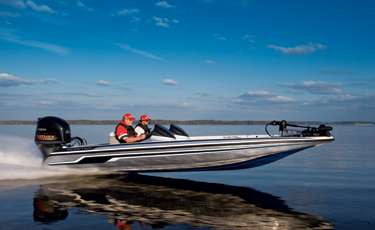
Few things are more aggravating than having another bass boat of similar horsepower blow by you while you're running down the lake.
Skeeter Boats pro staffer Harold Allen is one of those guys who is likely to go around you. He's been driving bass boats since the early 1970s and has learned a few tricks to help squeeze a few more miles per hour out of his rig.
"Speed isn't affected by one thing but by a combination of factors," he explains. "They may only get you another 1 to 3 miles per hour, but on a long run down the lake that can make a difference in whether you get to a hot spot first and how many more casts you make. It all equates to being a more efficient angler."
First and foremost, he adds, you've got to understand a boat's hull design and weight. Some boats make excellent fishing platforms but aren't as efficient when it comes to top-end speed and fuel economy.
"There are boats that run extremely fast on slick water, but when you put them in a rough-water fishing situation they aren't the optimum choice," he says.
Here are some of the basic steps Allen recommends you do to gain a few extra miles per hour:
Load the boat properly
Put all the heavy gear in the back of the boat. That includes soft plastic lures, tools and anchors.
"You may lose a little in the holeshot, but the boat will use less energy for forward propulsion, which equates to speed and better fuel economy," he adds.
Empty the livewells
You'll be shedding weight and gaining horsepower.
Remove boat seats
It makes a difference, says Allen, as he discovered in the 1990s when he removed the two butt seats from his 19-foot Skeeter rigged with a 150-horsepower Yamaha.
"I gained a full mile per hour with the seats down lying in the floor," he offers. "You wouldn't think there would be that much wind drag from the seats, but there is."
Don't over-trim
Allen says there are times when you can get more speed from a lower RPM (with the motor trimmed lower) than you can with the motor trimmed up and a higher RPM.
"Just tweak it a little and watch the GPS speed," he says. "Those things are pretty darn accurate and can help you find the best trim spot."
Use a hydraulic jack plate
They allow you to tune the motor height and match water conditions at any given moment.
"I've seen motors with manual jack plates set at optimum settings blow out in rough water because the motor was too high," Allen explains. "The hydraulic jack plate also allows you to get on plane faster in shallow water, and that translates into more fishing time."
Run the right propeller
A three-blade prop typically runs a boat faster, but boats that need transom lift may require a four-blade prop to get maximum performance. An experienced dealer can help you.
"Also, if the prop is dinged or damaged, you're going to lose performance," Allen says.
In addition, he adds, prop specialists can create a custom prop tuned to your rig that has the potential of getting you another 3 to 5 miles per hour. They may cost more but will get you better overall speed and performance.

